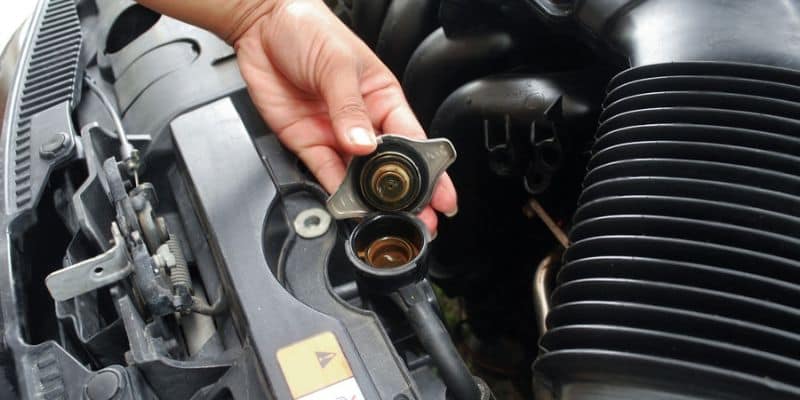Maintaining the proper pressure in a vehicle’s cooling system is crucial for optimal engine performance and preventing overheating.
The radiator cap plays a vital role in regulating this pressure. However, when the pressure in the cooling system becomes too high, it can lead to undesirable consequences.
This article will explore what happens if radiator cap pressure is too high and how it can impact the engine’s health and overall performance.
The function of the Radiator Cap
Before we explore the consequences, let’s understand the function of the radiator cap. The radiator cap is a pressure release valve and maintains the ideal pressure level within the cooling system.
It is designed to hold a specific pressure, typically measured in pounds per square inch (psi). This pressure raises the boiling point of the coolant, allowing it to absorb and dissipate heat more effectively.
Consequences of High Radiator Cap Pressure
1. Coolant Boiling and Engine Overheating
One of the primary consequences of high radiator cap pressure is the increased likelihood of coolant boiling.
When the pressure exceeds the cap’s specified limit, the coolant’s boiling point decreases, causing it to boil at lower temperatures than intended. This can lead to rapid overheating of the engine, as the coolant can no longer effectively absorb and dissipate heat.
Engine overheating can result in severe damage to various engine components, such as the cylinder head, gaskets, and pistons.
2. Coolant Loss and Inadequate Cooling
Another consequence of high radiator cap pressure is the potential for coolant loss from the cooling system.
Excessive pressure can force the coolant to escape through any available outlet, such as a damaged hose or a weak gasket seal.
This coolant loss can lead to an insufficient amount of coolant circulating through the system, resulting in inadequate cooling of the engine.
Without proper cooling, the engine’s temperature can rise rapidly, leading to overheating and potential engine damage.
Furthermore, coolant loss can disrupt the balance of the cooling system, which relies on a specific coolant-to-water ratio for optimal performance. Insufficient coolant levels can disrupt this balance and compromise the system’s ability to regulate temperature effectively.
3. Strain on Cooling System Components
High radiator cap pressure places excessive strain on various components of the cooling system. The increased pressure can stretch and weaken hoses, leading to potential leaks or bursts.
Additionally, gaskets and seals that are not designed to withstand such high pressure may fail, resulting in coolant leaks and loss. These leaks can further exacerbate the cooling system’s inefficiency, leading to inadequate cooling and potential engine overheating.
Moreover, the strain on cooling system components can extend beyond hoses and gaskets. The radiator itself, along with its associated parts, may suffer damage under excessive pressure.
The radiator’s core, which facilitates heat exchange, can become compromised, reducing its effectiveness in dissipating heat. Overall, the strain caused by high pressure can significantly impact the durability and lifespan of cooling system components.
4. Improper Pressure Release
In extreme cases, when the pressure within the cooling system exceeds the capacity of the radiator cap, it may fail to release pressure as intended.
This can occur due to a malfunctioning cap or a clogged pressure release valve. As a result, the pressure within the system continues to build up, potentially reaching dangerous levels.
The consequences of improper pressure release can be severe. The excess pressure can cause structural damage to the radiator, leading to leaks or even rupture.
It can also impact other components, such as the water pump or thermostat, causing them to malfunction. Ultimately, the inability to release pressure can result in catastrophic damage to the entire cooling system.
5. Effects on Fuel Efficiency
High radiator cap pressure and the resulting engine overheating can indirectly affect fuel efficiency.
When the engine operates at higher temperatures, it can lead to increased friction and inefficiencies in the combustion process. This can result in reduced fuel efficiency and increased fuel consumption.
Therefore, addressing high radiator cap pressure is not only important for the engine’s health but can also contribute to improved fuel economy.
6. Impact on Emissions
Engine overheating caused by high radiator cap pressure can also impact emissions.
When the engine operates at higher temperatures, it can lead to incomplete combustion and increased emissions of pollutants such as nitrogen oxides (NOx) and carbon monoxide (CO).
This can have adverse effects on air quality and contribute to environmental pollution. By maintaining proper radiator cap pressure and preventing engine overheating, we can help reduce emissions and promote cleaner air.
Signs of High Radiator Cap Pressure
1. Coolant Leaks
One of the telltale signs of high radiator cap pressure is the presence of coolant leaks. Excessive pressure can cause coolant to escape through weakened hoses, damaged gaskets, or faulty seals.
Look for puddles or stains of coolant beneath your vehicle, particularly around the radiator hoses.
Coolant leaks may also manifest as visible drips or a sweet smell coming from the engine bay.
2. Overheating
High radiator cap pressure can contribute to engine overheating. If the pressure exceeds the cap’s specified limit, the coolant’s boiling point decreases, leading to premature boiling and inadequate cooling.
Keep an eye on your temperature gauge or warning light on the dashboard. If you notice the engine temperature rising rapidly or consistently running in the red zone, it could be an indication of high pressure within the cooling system.
3. Hissing Sounds
When the radiator cap is under excessive pressure, you may hear hissing sounds from it or the cap itself. This sound is caused by steam or coolant being released as pressure escapes.
If you hear a persistent hissing sound, it is advisable to inspect the radiator cap and the cooling system for potential issues.
4. Visible Coolant Spray
Coolant spray when the cap is removed is another visible sign of high radiator cap pressure.
Exercise caution when inspecting the radiator cap, as the pressure release can cause a sudden release of hot coolant.
If you notice coolant spraying out or a sudden rush of steam, the pressure within the system is too high.
5. Bulging or Deformed Radiator Hoses
Inspect the radiator hoses for any signs of swelling, bulging, or deformation. High pressure can put excessive strain on the hoses, causing them to expand beyond their normal shape.
This can weaken the hoses and make them more prone to leaks or bursts. A visual examination of the hoses can help identify potential issues related to high radiator cap pressure.
6. Reduced Coolant Level
If you frequently find yourself needing to top up the coolant level, it could be an indication of high radiator cap pressure.
Excessive pressure can cause coolant to escape through leaks or during the pressure release.
Regularly monitor your coolant levels and keep an eye out for any significant decreases that cannot be attributed to normal consumption.
If you observe any of these signs, it is crucial to address the issue promptly. High radiator cap pressure can lead to engine damage and compromised cooling system performance.
Seeking professional assistance from a qualified mechanic is recommended to diagnose and resolve the underlying problem causing the high pressure.
Addressing High Radiator Cap Pressure
Given the potential consequences associated with high radiator cap pressure, it is crucial to address the issue promptly.
Here are some steps to consider:
Regular Maintenance
Regular maintenance of the cooling system is essential to prevent issues with the radiator cap and maintain proper pressure.
Follow the manufacturer’s recommended service intervals and have the cooling system inspected by a qualified mechanic.
Signs and Symptoms
Familiarize yourself with the signs and symptoms of high radiator cap pressure. These may include coolant leaks, overheating, hissing sounds from the radiator, or visible coolant spray when the cap is removed.
If you notice any of these warning signs, it’s important to investigate and address the issue promptly.
Seeking Professional Assistance
If you suspect high radiator cap pressure or encounter any cooling system problems, it is advisable to consult a qualified mechanic.
They can diagnose the underlying issue, such as a faulty cap, a malfunctioning pressure release valve, or other cooling system problems.
Prompt professional assistance can help prevent further damage and ensure the cooling system operates optimally.
What causes high radiator cap pressure?
High radiator cap pressure can be caused by various factors. A malfunctioning radiator cap, a clogged pressure release valve, or an underlying issue within the cooling system can contribute to increased pressure.
Additionally, factors like a malfunctioning thermostat, a blocked radiator, or a faulty water pump can disrupt the cooling system’s balance and result in elevated pressure levels.
Can high radiator cap pressure lead to engine damage?
Yes, high radiator cap pressure can potentially cause engine damage.
The consequences of high pressure include coolant boiling and engine overheating, coolant loss, inadequate cooling, the strain on cooling system components, and improper pressure release.
These factors can collectively lead to severe engine damage, such as cylinder head warping, blown head gaskets, or piston failure.
Timely detection and resolution of high radiator cap pressure are essential to prevent costly engine repairs.
How can I check if my radiator cap is causing high pressure?
To check if your radiator cap is causing high pressure, you can perform a visual inspection. Look for signs of damage, corrosion, or worn-out seals on the cap.
Additionally, you can use a pressure tester tool, available at auto parts stores, to measure the pressure release point of the cap.
If the pressure release point is significantly higher or the cap fails to release pressure within the specified range, it may indicate a faulty radiator cap contributing to high pressure.
What should I do if I suspect high radiator cap pressure in my vehicle?
If you suspect high radiator cap pressure in your vehicle, it is important to address the issue promptly.
Here are some steps you can take:
- Safely park your vehicle and allow the engine to cool down.
- Inspect the radiator cap for any visible signs of damage or wear.
- Check for coolant leaks or bulging hoses, which may indicate high pressure.
- Consider consulting a qualified mechanic for a thorough inspection and diagnosis.
Follow the recommendations of the mechanic to resolve the underlying issue, which may involve replacing the radiator cap, addressing cooling system malfunctions, or performing repairs as needed.
Conclusion
High radiator cap pressure can have significant consequences on the performance and health of a vehicle’s engine.
From coolant boiling and engine overheating to coolant loss and strain on cooling system components, the potential outcomes can be severe.
It is crucial to prioritize regular maintenance, pay attention to warning signs, and seek professional assistance when needed.

Joseph Morgan has decades of automotive experience. The Detroit native started restoring classics in the 1970s. He owned a vintage repair shop and authored articles for car magazines. With a 1965 Mustang fastback of his own, Joseph now shares advice through his YouTube channel. From engine swaps to rust repair, his expertise helps preserve automotive history.
